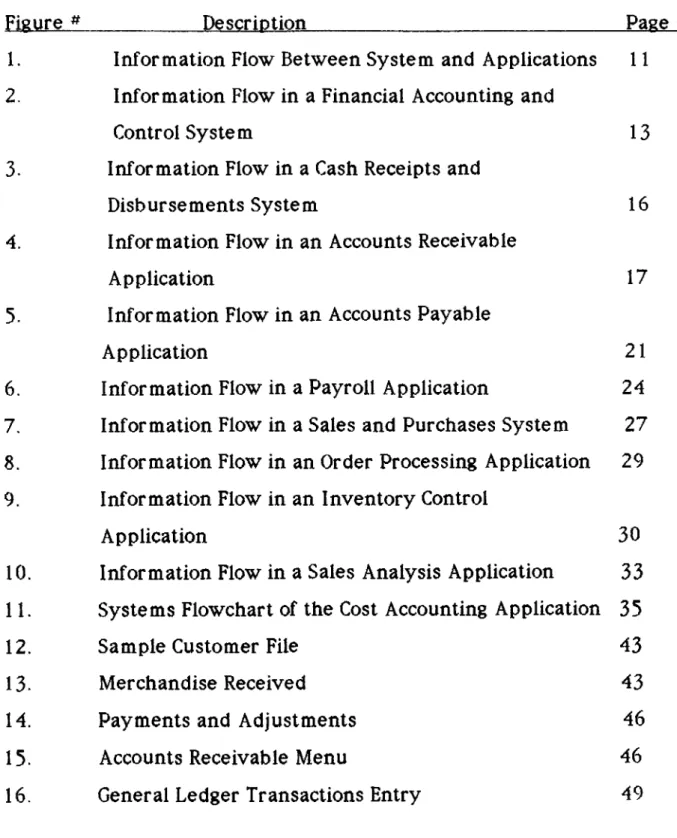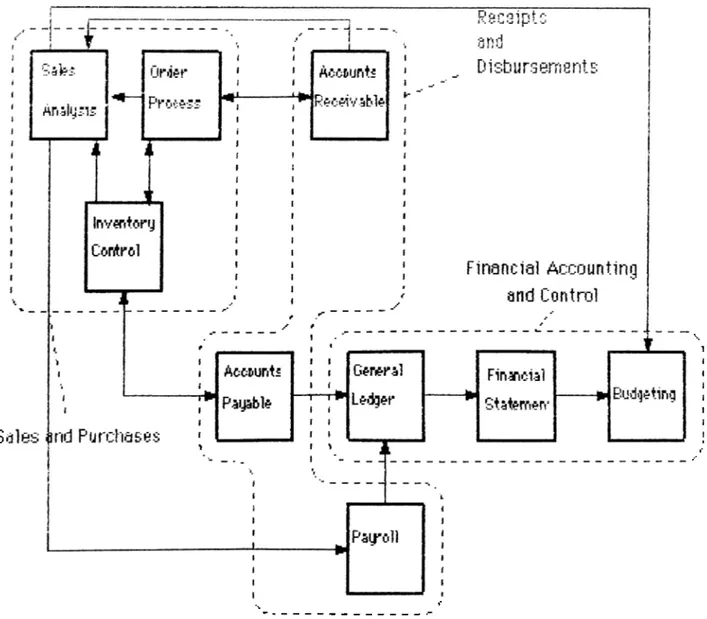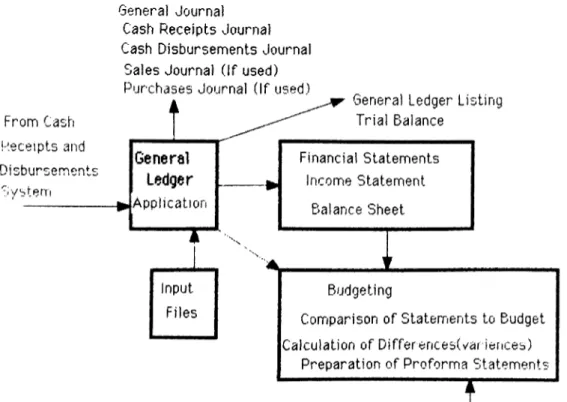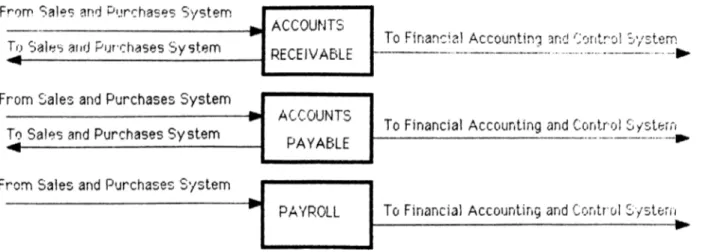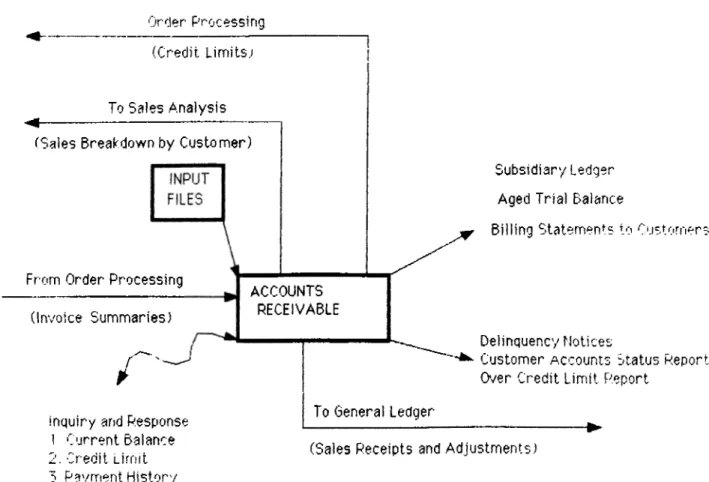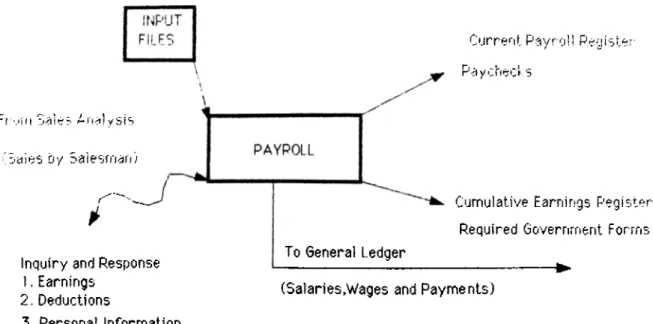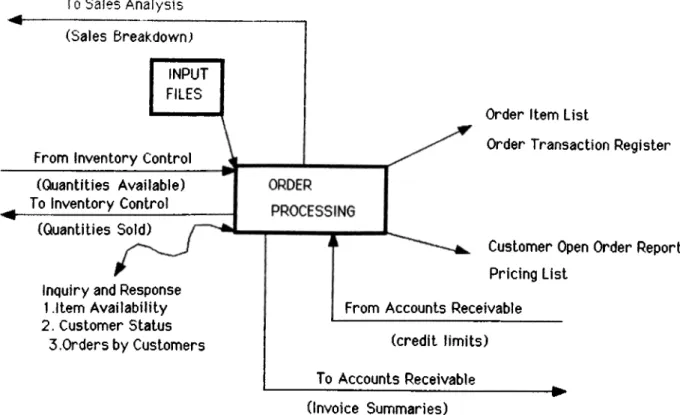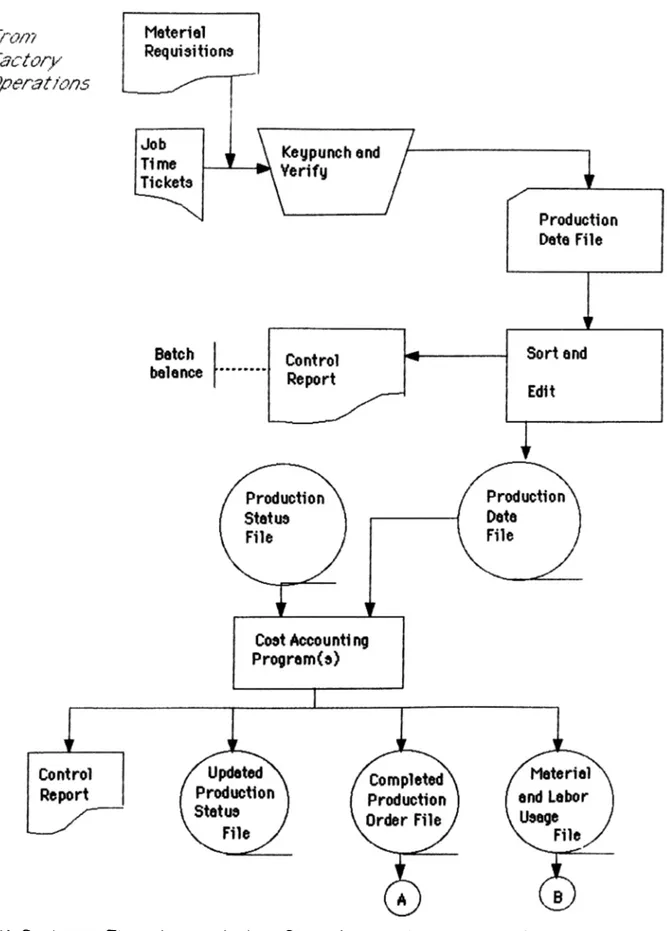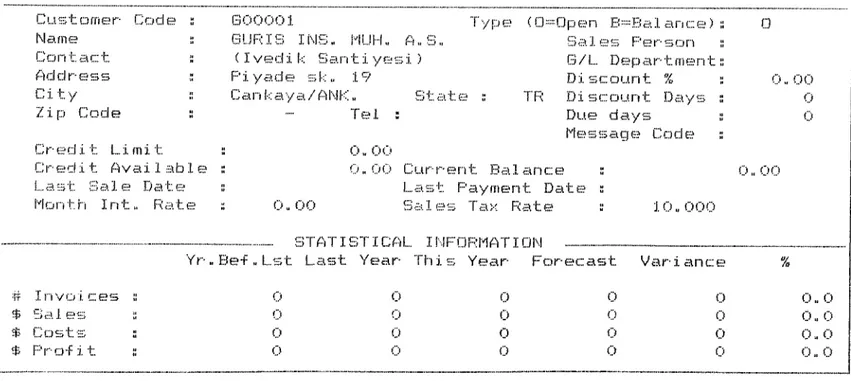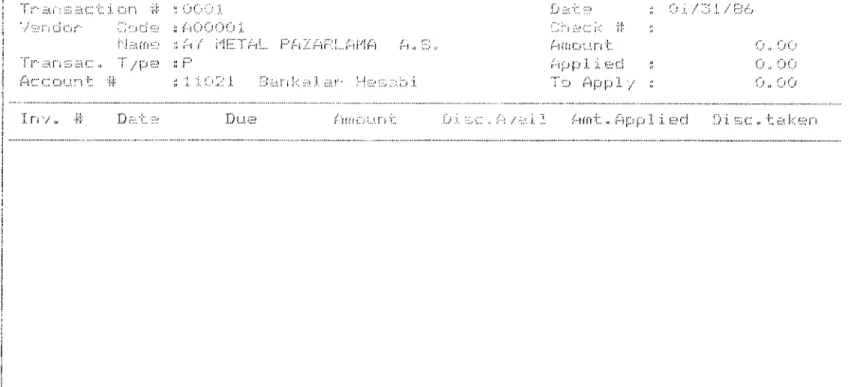Äi^coMniing System· Of A
Smalt Fi;rm к lyítesy To
A
СшфіЁві Based One
"ii ^ 1 - ' C' ' 5w • /·! >; '■. ; ' d ?
CONVERTING THE MANUAL ACCOUNTING SYSTEM OF A SMALL FIRM IN TURKEY TO A COMPUTER BASED ONE
A THESIS
SUBMITTED TO THE DEPARTMENT OF MANAGEMENT AND THE GRADUATE SCHOOL OF BUSINESS ADMINISTRATION
OF BILKENT UNIVERSITY
IN PARTIAL FULFILLMENT OF THE REQUIREMENTS FOR THE DEGREE OF
MASTER OF BUSINESS ADMINISTRATION
By
Ferhat Naci GÜNGÖR
February, 1989
frc·
~Τ h es is H P ^ i'^ 9 G 9 r é l Я ? 9 ^ " Ш
I certify that I have read this thesis and that in my opinion it is fully adequate, in scope and in quality, as a thesis for the degree of Master of Business Administration.
Assist. Prof. Can 3imga
I certify that I have read this thesis and that in my opinion it is fully adequate, in scope and in quality, as a thesis for the degree of Master of Business Administration.
L A ' ' ^ \
i
-Assist. Prof. KUr§at Aydogan
I certify that I have read this thesis and that in my opinion it is fully adequate, in scope and in quality, as a thesis for the degree of Master of Business Administration.
Assist. Prof. Erdal Erel
Approved for the Graduate School of Business Administration
^ ^ LV#(^__^.QßdAM'·
I would like to acknowledge tny indebtedness to a number of people for their valuable contributions. Assist. Prof. Can ŞIMGA has contributed her ideas and experiences from the beginning of the thesis till the end. I would also like to express my gratitude to Assist. Prof. Erdal EREL and Assist. Prof. Kür şat AYDOGAN for their valuable criticisms.
Finally, I wish to mention my appreciation for my father, for his patience and encouragement.
ACKNOWLEDGEMENTS
ABSTRACT
CONVERTING THE MANUAL ACCOUNTING SYSTEM OF A SMALL FIRM IN TURKEY TO A COMPUTER BASED ONE
Ferhat Naci GÜNGÖR M.B.A. in management
Supervisor: Assist. Prof. Can Şımga February 1989, 95 pages
In this thesis, the conceptual fram ework of the computer-based accounting information system w ill be discussed. Then, the framework w ill be applied to a small firm in iron&steel industry for financial accounting and control, cash receipts and disbursements, sales and purchases system design. For this purpose, a standard package, namely, Dac-Easy accounting version 2.0 w ill be used.
Keywords: Accounting Information System (AIS), Financial Accounting and Control, Cash Receipts and Disbursements, Sales and Purhases.
ÖZET
TÜRKİYE'DE FAALİYET GÖSTEREN KÜÇÜK BİR FİRMANIN MUHASEBE İŞLEMLERİNİN BİLGİSAYARLA YAPILM ASI
Ferhat Naci GÜNGÖR İş İdaresi Yüksek Lisans Denetçi: Yrd. Doç. Dr. Can Şımga
Şubat 1989, 95 sayfa
Bu tezde bilgisayar bağımlı muhasebe bilgi sistemlerinin kavramsal çatısı
anlatılacak. Daha sonra bu bilgi, demir-çelik endüstrisinde faaliyet
gösteren küçük bir firm aya tiçari mühasebe v e kontrol, nakit giriş ve çıkışı,
mal alış ve satış sistem dizaynı için kütlanılacak. Bü amaçla, standart bir
paket olan Dac-Easy Acçoünting versiyon 2.0 dan yararlanılacak.
Anahtar Kelimeler: Mühasebe Bilgi Sistemi, Ticari Mühasebe ve Kontrol, Nakit Girişi ve Çıkışı, Mal Alış ve Satışı
TABLE OF CONTENTS
Subject __________________________________________________________ Page #
CHAPTER 1 -THE PROBLEM 1
1.1 Introduction 1
1.2. The Need for Computerization 2
1.3. Iron & Steel Industry 4
1.4. The Selected Firm ... 5
1.5. Expected Use of an Accounting Package 6 1.6. Other Intangible Benefits ... 8
CHAPTER 2-COMPUTER-BASED INFORMATION SYSTEMS 10 2.1. Financial Accounting and Control Systems 10 2.2. Cash Receipts and Disbursements Systems 16 2.3. Sales and Purchases Systems ... 26
2.4. Cost Accounting 34 CHAPTER 3- METHODOLOGY ... 39
3.1. Introduction ... 39
3.2. Brief Notes on the Software Used ... 39
3.3. The Conversion Process ... 39
CHAPTER 4-FINDINGS ... 50
4.1. Evaluation ... 50
CHAPTER 5-THE FUTURE AND CONCLUSION ... 57
5.1. The Future ... 57
5.2. Conclusion ... 59
REFERENCES ... 61
APPENDIX A- SAMPLE CUSTOMER LIST 62 APPENDIX B-SAMPLE VENDOR LIST ... 69
APPENDIX C- FINANCIAL STATEMENTS 75 APPENDIX D -T R IA L BALANCE ... 79 APPENDIX E- JOURNALS & ACCOUNT ACTIVITY DETAIL REPORT. 81
LIST OF FIGURES
Figure # Description Page
1. 2. 4. 5. 6. 7. 8. 9. 10. 11. 1 2. 13. 14. 15. 16.
Information Flow Between System and Applications 11
Information Flow in a Financial Accounting and
Control System 13
Information Flow in a Cash Receipts and
Disbursements System 16
Information Flow in an Accounts Receivable
Application 17
Information Flow in an Accounts Payable
Application 21
Information Flow in a Payroll Application 24
Information Flow in a Sales and Purchases System 27
Information Flow in an Order Processing Application 29
Information Flow in an Inventory Control
Application 30
Information Flow in a Sales Analysis Application 33
Systems Flowchart of the Cost Accounting Application 35 Sample Customer File
Merchandise Received Payments and Adjustments Accounts Receivable Menu
General Ledger Transactions Entry
43 43 46 46 49 v i i
CHAPTER 1. THE PROBLEM
1.1 Introduction
Information is useful data, organized so that correct decisions can be based on it. A system is a collection of resources related such that certain objectives can be achieved. Accounting, as an information system, identifies, collects, processes and communicates economic information. All accounting information and reporting can be divided into three categories which provide different summaries of data that are significant to meet varying user requirements (Michael R. Tyran, 1972):
a) Operating Data;
It functionally represents the basic record of "what happened'. This information is used primarily by operating organizations to monitor detailed performance and schedule and provide the basic data for the hierarchy summary reporting. The reporting at this level is concerned w ith data related with design, engineering, production, inspection, etc. of products and performance. Also, operating transaction data, like the
initiation and placement of purchase orders resulting in vendor
commitments, customer invoicing, acquiring fixed assets, paying vendors and employees would be included.
b) Tactical Information
Tactical Information highlights problem areas in the general ledger account structure and trial balance that provide account detail for analysis
and overview of financial operations' status. Through review and analysis of these data, management is able to monitor the actual versus planned effort and take corrective action for correcting inadequacies by redirecting effort.
c) Strategic Data
Strategic data are information used by top level management to support
strategic planning and decision making. Strategic Data are used in
simulating alternative courses of action and is a tool that allows management the capability of view ing their overall financial operations in terms of required and/or critical needs. Financial schedules incorporate such statistics as working capital position, inventory balances, ratio of current assets to liabilities, net investment, profit and its associated detail.
1.2. The Need For Computerization
In order to stay competitive, modern business organizations depend on information systems. Productivity, which is a measure of the relative amount of input used in achieving a given amount of output, is vital for staying competitive and can be increased through better information systems. The rate of change reflecting increased research and development efforts, the growth of business and the acceleration of competition have increased the complexity of the business world. In order to support the
decision makers with timely, accurate, valid and relevant information,
large quantities of data are to be processed which takes more time and thus not efficient if done manually. The answer to this problem is the commercialized present day computers operating at fantastic speed and
accuracy.
The computer has brought many changes to how business is conducted. Electronic images on a screen or within a computer's memory are replacing physical documents and records. Computerized accounting systems, using personal computers, are now available for even the smallest businesses. Electronic spreadsheets and database management systems are w idely used. Computers have helped to create new investment instruments, such as stock index futures and options. Securities markets around the world are linked by telecommunications networks and computers so that trading is carried out twenty-four hours a day, and customers' accounts have been computerized. Electronic Funds Transfer Systems move large sums of money over worldwide networks. Salespeople away from their home offices can forward daily orders to their headquartes' computer systems using a telephone modem attached to a portable computer the size of a briefcase (Infoworld, 1987).
There are two significant facts about computer based systems:
One is that, the speed offered by the computer allows the ledger
accounts to be kept continually upto date and current reports may be prepared quickly at any time to assist executives in making decisions.
The other is that, many processing applications use the same basic data as input but require that the data be organized or accessed slightly differently. The output of some applications may be used as input for applications in other component systems. This commonality of data needs makes it possible for a computer-based system to create a basic set of data
.called database which is available to all processing applications and can be referenced by these applications in many different ways, instead of each application process organizing and storing all of its own data, the database concept extracts data that is common to many processing applications and makes it accesible to all. This is efficient and tim ely with the help of a computer's speed and memory.
Taking into consideration the factors mentioned above, it is decided to convert the manual accounting system of a small firm operating as a marketer in iron&steel industry, in Turkey, to a computer-based one. In the chapters that follow, the conceptual fram ework of the computer-based accounting information system w ill be discussed. Then, the framework w ill be applied to the firm for financial accounting and control, cash receipts and disbursements, sales and purchases system design.
In this new system development, a standard package, namely, Dac-Easy Accounting Version 2.0 w ill be used. Then the package w ill be evaluated and finally the future of computers w ill be discussed briefly, followed by drawing some conclusions about the system development.
1.3· Iron & Steel Industry
The firm operates as a wholesaler in the iron&steel industry in Turkey. Particular interest is on construction iron. There is a dependency on demand and supply, production and inventory on hand in determining price. The industry is highly volatile, in the sense that prices change very frequently.
There is high competition, but the firm benefits from loyalty. The manager said that 'We sometimes sell at higher prices than our competitors, but the customers prefer to buy from us, since they know that we keep our word ; trust is extrem ely important in our industry because the amount of money involved in our business is v e ry high . Also , to able to meet the demand in time is an extrem ely important issue, since a construction can not w a i t ; time is money
As far as the resources are considered, cash is the most important capital. The firm can use either its own capital or the short-term credits offered by the manufacturers. Since the profit margin is low, bank credits are never used.
1.4. The Selected Firm
The firm was established on January 1^^ 1979 in Siteler Samsun Yolu No.26 as Çınar Demir Ticaret Ltd. Şti. and in 1984 it was reestablished as Çınar Demir Ticaret, Çınar Güngör. The firm owns a 3500 m"^ open space for inventory, including a truck balance with a capacity of 60 tons, worker units, and a closed area for inventory.
The next step should be to determine the scope and boundaries of the system, i.e. what the system w ill and w ill not do.
Periodically, a listing is produced of all general ledger accounts and beginning balances, together with a summary of debit and credit activity in
each account and the ending balances. A trial balance could then be
produced proving the equality of debits and credits in the system. Finally, at the end of each period the traditional accounting financial statements can be produced according to any format specified by the system user.
An important part of a financial accounting and control system is the control aspect. Budgeting is an important part of any control system and can be accomplished as an extension of financial statement preparation.
1.3.2. Cash Receipts and Disbursements
1.3.2.1. Accounts Receivable Component 1.3· Expected Use of an Accounting Package
1.3.1· Financial Accounting and Control
The most important variable in the success of the business is cash flows. Control of cash flows is absolutely essential to the short-term and long term stability of the business. The most important sources of operating
cash inflows are sales and collections of receivables. The accounts
receivable component can monitor these cash inflows and provide information which will, to the extent possible, reduce the amount of cash tied up in receivables. Basically, this processing package should provide information on 1) who owes us money, 2) how much, 3) for how long, and 4) past receivables collection experience.
Equally important to the overall control of cash and cash flows are those transactions which affect cash outflows. These are primarily purchases of merchandise and payment of amounts due suppliers. The accounts payable component can monitor these cash outflows and provide information which w ill aid in the control of the costs and expenses associated with the flows. Basically, this processing package should provide information on 1) who we owe money 2), how much, and 3) for how long.
The idea is to process payables so that cash outflov/s 'will not occur any sooner than necessary.
1.5.3. Sales and Purchases System
1.5.3.1. Order Processing Component 1.5.2.2. Accounts Payable Component
The aim of this package is to provide fast and accurate processing of orders from customers while minimizing the clerical costs and costs associated with customer dissatisfaction. Basically, this processing package should provide information on 1) whether sales orders have been properly filled, 2) if items sold have been properly priced, 3) the status of unfilled orders.
The goal is to maximize customer service while controlling the costs associated with the processing of customer orders.
The purpose of this package is to provide information which aids in the control of inventory and on w^hich purchase decisions can be based, so that
total costs associated with the purchase function are minimized. The
inventory control processing package should tell us 1) if purchases have been properly timed, 2) if purchase orders have been properly filled and costed, 3) the status of inventory on hand and item availability.
The focus of this application is on maintaining appropriate levels of inventory to meet customer demands.
1-5.3-3. Sales Analysis Component
The goal of sales analysis is to provide information which w ill aid management in 1) predicting future sales activity and profitability for the business and 2) evaluating the past performance of products and
customers. As such, management can be better able to anticipate the
future and make decisions accordingly, spot difficulties while they are correctable.
1.6. Other Intangible Benefits
One important intangible benefit is capacity-the system's ability to easily handle increasing volumes of transactions; manual systems often require extensive hiring and training of new personnel to process an increased volume of transactions. A second intangible benefit is timeliness; a w ell designed computer system can often generate results faster, which can help improve decisions since (more current) information is available.
1.5.3-2. Inventory Control Component
A third intangible benefit is reliability or accuracy. A standard problem in manual systems is errors in computation, such as incorrectly extending
price times quantity for invoices. Such errors reflect poorly on the
company and may lead customers to suspect they are being cheated. The computer can perform such tasks easily, without fear of error. A fourth intangible benefit is improvement of service. For instance, the manual sales system typically requires filling out various forms, mailing them to the company, processing the forms, etc. A computer system can eliminate such delays and speed goods to customers days or even weeks earlier. A fifth intangible benefit is additional or improved information.
Three computer systems which commonly make up an accounting information system w ill be presented (John R. Page & H. Paul Hooper). These systems track the manual processing techniques for the accounting system and process accounting transactions with the aid of a computer.
The primary (but not necessarily the only) components of an
information system are: ( Figure 1)
a) Financial accounting and control system b) Cash receipts and disbursements system c) Sales and purchases system
It is v e ry important to note that information flow between applications within a system, as w ell as between applications of different systems, is absolutely necessary in a computer-based information system. The arrows indicating information flow which intersect the curved shapes show that all systems interact with each other.
CHAPTER 2. COMPUTER BASED INFORMATION SYSTEMS
2.1. Financial Accounting and Control Systems
Figure 1. InformBlion Flow Between Systems and Applications
Reference; John R. Page & H. Paul Hooper, Reston Publishing Co. Inc., 1963 p.3 1 5.
By observing the relationships in Figure 1, two significant conclusions about computer-based systems can be drawn;
1. The flow of information between applications and systems makes it unlikely that any individual application, or even any cornpjonent system,
provide the necessary "environment" for the other. To think about the whole IS an important lesson of the systems approach.
L·. iMany processing applications use the same basic data as input, but
require that the data be organized or accessed slightly differently. The output of some applications may be used as input for applications in other component systems. This commonality of data needs makes it possible for a computer-based system to create a basic set of data, called database which is available to all processing applications and can be referenced by these applications.
2.1.1. Components of Financial Accounting and Control System :
This is the most basic of the processing systems. Figure 2 shows the information flow in a financial accounting and control system (John R. Page & H. Paul Hooper, 1983)·
One should note that the cash receipts and disbursements system
provides input for the general ledger application of the financial
accounting and control system. The reason is that, the accounts receivable, accounts payable, and payroll applications supply much of the data necessary for the creation of the cash receipts and cash disbursement journals as w ell as the sales and purchases journals.
General Journal Cash Receipts Journal Cash Disbursements Journal
Sales Journal (If used)
Figure 2 . Inform ation Flow in a Financial Accounting and Control System
2.1.2. Output Requirements :
There should be several man-sensible output reports in addition to permanent files of data stored being updated for further processing. The first reports are the company's journals. The following information about these journals should be noted ;
1. General journal : Data are entered directly into the financial accounting and control system from source documents. The journal reference number is assigned by the system as entries are made to keep the sequence of events and provide an audit trail. A brief description of each transaction is also provided.
accounts receivable. This journal focuses on cash receipts from the collection of receivables, leaving other cash receipts, like cash sales to be recorded elsewhere.
■k Cash Disbursements lournal : The focus is on the disbursements for the payment of accounts payable, with other cash flows appearing in the general journal.
4. Sales journal-invoice register: It presents a record of all sales invoices.
It is closely related to the cash receipts journal.
5. Purchases lournal: This journal is closely related to the cash
disbursements journal as it records all purchases as they are received.
£ncf o f P e rio d R eports :
Reports va ry from a trial balance of the general ledger accounts to formal financial statements. All adjusting entries are entered as direct input to the general ledger application. In a manual system, the journals are constantly available, while in a computer system journal information is stored.
2.1.3· Data Organization and Input :
The major files necessary for the general ledger application :
1. General Ledger Master file . This file would contain one record for each general ledger account in the chart of accounts used by the company. .At
least the iollowing data elements would be present in each record. a) Account number
b ) Account description
cj Account classification »'asset, liability, owner s equity, revenue, or expense I
d) Current year balances-by month. e) Previous year balances-by month, f ) Budgeted balances-by month.
This file is updated with each processing, then stored, and used again as input.
2. Current month transaction file. This file would consist of one record for each detailed and verified accounting transaction which occured during the current month. Input data from this file would be used to update the general ledger master file.
■3. Permanent transaction file. It represents a cumulative listing of all the monthly transaction files. This file, unlike the current transaction file is retained and contains all the detailed and verified accounting transactions for the year.
An important feature of all computer-based files is that unlike
manually maintained data files, computers give the user an opportunity to immediately access important segments of data, as w ell as, group that data by various criteria, which may be useful for decision making, planning or
control. For example, all transactions affecting cash for a given period
could be pulled from the permanent transaction file and printed in report form with little difficulty.
Reí erring back to Figure 1, important information flow takes place betVveen the general ledger and the cash receipts and disbursements system. In fact, this flow is essentially one-way from the processing applications of the cash receipts and disbursements system to the general ledger application of the financial accounting and control system. Figure 3 illustrates the information flow through the system (John R. Page L· II. Paul Hooper, 1983) :
2.2. Cash Receipts and Disbursements Systems :
Figure 3. Inform ation Flow in a Cash Receipts and Disbursements System
Notice the large amount of information flow to and from this central system. The cash receipts and disbursements system stands between (in an information flow sense) the other two major processing systems. The accounts receivable and accounts payable applications receive input from
the sales and purchases system and provide output to that system Since
accounts receivable are usually a factor in both sales and cash receipts and accounts payable a factor in purchases and cash disbursements, this
interaction is not surprising. Moreover, the receivables and payables
applications produce essential output information on these transactions for
inclusion in the general ledger by the financial accounting and control system.
2.2.1. Accounts Receivable Component :
The accounts receivable application is designed to monitor cash inflows due to sales and collection of receivables and provide information which w ill to the extent possible, reduce the amount of cash tied up in receivables. Figure 4 summarizes the information flow (John R. Page & H. Paul Hooper, 1983):
Order Processing (Credit Limits.)
To Sales Analysis (Sales Breakdown by Customer)
From Order Processing (Invoice Summaries)
Subsidiary Ledger Aged Trial Balance
Billing Statemen':5 to Customers
ACCOUNTS RECEIVABLE
Delinquency Notices
Customer Accounts Status P.eport Oyer Credit Limit Report
inquiry and Response I Current Balance 2. Credit Limit 3 Payment History
To Oeneral Ledger
(Sales Receipts and Adjustments!
FIGURE 4 . inform ation Flow in an Accounta Receivable Application
other processing applications. The information that results from the transactions processed by the receivables package is often essential to the functioning of other systems. One of the important inputs to the general ledger comes from the sales and cash receipt transactions of the receivables package.
Additionally, interaction takes place between receivables and the sales analysis and order processing packages of the sales and purchases system. Accounts receivable provides information on customer sales breakdowns to the sales analysis package and important credit limit and history information to the order processing application. Order processing, then, passes summary information on all sales orders processed by that
application to accounts receivable. The flow is, therefore, constantly
two-way, with each producing information that is used by the other. Much of the flow represents information but not accounting transactions.
The curved line leading to inquiry/response in Figure 4 is an input/output line indicating an on-line connection between a terminal and the receivables package, so that questions concerning current customer account balances, credit limits, and payment histories can be immediately answered by the computer.
2.2.1.1. Output Reports :
A. Subsidiary Led2er : The detailed information necessary to do the
monitoring and collection is contained in the subsidiary ledger accounts for each customer. Individual transactions are listed (Sales,returns, customer payments.! and totaled to show the amount owed by each customer.
B. ARed Trial Balance : Before producing billing statements for customers, an aged trial balance is printed for management analysis and audit purposes. It provides a complete listing of amounts owed by each customer for each invoice outstanding and in total as of the statement date.
C. BillinR Statements : Important for the control of cash inflows since it reminds customers of the amounts owed and usually triggers payment.
2.2.1.2. Input Files :
A. Customer master file. The following are the possible data elements for each customer record :
a) Customer account number b) Customer name c) Customer address
(including city) d) Credit limit e) Credit history code f) Current Balance by age gj Collections-year-to-date h) Finance charges i) Collections-previous year
This file is updated with each processing and is the database for all system inquiries. The customer master file is the accounts receivable subsidiary ledger in a computer-based system and provides detailed information on sales to and collections from each customer, as well as amounts owed by each customer at any lime.
B. New invoices file . This transaction file is made up of all verified sales invoices created since the last processing of accounts receivable. It may be
to the general ledger of the financial accounting and control system.
C. Cash receipts and adjustments file . It provides input data for the
updating of the customer master file. These transactions are the basis for the cash receipts journal discussed earlier.
2.2.2. Accounts Payable Component:
The accounts receivable package just discussed is concerned with processing the transactions (sales, receipts, and adjustments) whose ultimate impact is on the cash inflows of a business. However, equally important to the overall control of cash and cash flows are those transactions which affect cash outlows. These are primarily purchases of merchandise and payments of amounts due suppliers (accounts payable). The accounts payable application is designed to monitor these cash outflows and provide information which w ill aid in the control of the costs and expenses associated with the flows. Information flow is as seen in Figure 5 (John R. Page & H. Paul Hooper, 1983) ’·
The accounts payable application also produces output which is used by
other systems. There is interaction between accounts payable and the
general ledger as w ell as accounts payable and inventory control. The
payables package passes summarized total information on purchases, payments and adjustments to the financial accounting and control system to be included in the general ledger and in financial statements. Information is also exchanged with the inventory control package of the
sales and purchases system. Data on purchase invoices created in
inventory control serves as input to accounts payable, and vendor analysis
information which results from processing payables is returned to
/ r l y - ' t
r / f i f i . ' l o f F ' l ' t - y f - 'J 'J .'•v’ î r - ; )
INPUT FILES
From Inventory Control (Invoice Summaries)
ACCOUNTS PAYABLE
Open Payables Listing Cash Requirements h'.epor t Checks to Vendors
Vendor Analysis Reports
Inquiry and Response I ^ Amounts Due by Vendor 2. Ai'i'iounts Due by Date
To General Ledger
(Purchases,Payments and Adjustments)
flG U R t b . in fo rm atio n Flow in an Accounts P ayab le Application
inventory control to be used in future purchase decisions.
Some inquiry/response capability is desirable in processing accounts payable. This on-demand interaction with the system allows the user to acquire immediate information on monies owed to specific suppliers or total amounts owed to all suppliers now or as of certain future dates specified by the user.
2.2.2.1. Output Reports :
A Open oavables listing : The selection of which suppliers or invoices to
pay is a matter of cash planning. The open payables listing supplies all of the information about the total amounts owed each vendor, the discounts available from each, and the due dates of each amount. It allows the user to select particular accounts for immediate payment and to assign a
b. Cash Requirements R eport: It is a complete listing of all invoices and vendors to be paid during a period.
C. Checks to vendors : All of the information on the check stub can be
traced back to the cash requirements report,then to the open payables listing, and ultimately to the creation of the data in the sales and purchases system.
D. Vendor Analysis Reports : Reports showing purchase activity with
each supplier for the current period, the year to date, or the previous
year, as w ell as the discounts taken and lost from the same periods are available from the database. Thus, an overview of all purchases for a specified time period can be obtained, or the business' historical relationship with any one supplier can be examined. Information like this can be passed along to the inventory control application to be used in purchasing decisions.
2.2.2.2. Input Files :
payment sequence to the other amounts due.
A. Vendor master file : Data elements like a) vendor number b) vendor name c) vendor address (including city and state) d) vendor telephone number e) Name of established contact at vendor f ) Discount provisions g ) Payments-current period h) payments-year-to-date i) payments-previous
year j) discounts-current period k) discounts-year-to-date 1)
B. open invoices file : This file allows for retrieval of any or all open payables, and together with the vendor master file makes possible the determination of the total amount owed any specific vendor.
C. New invoices file : Input from here, which represents increases in
accounts payable, is the basis for updating both the vendor master file and the open invoices file. It also contains all the required information for the production of the purchases journal in the financial accounting and control system.
D. Cash Payments and Adjustments File : Data from this file completes the updating of the vendor master and open invoices files and is the basis for the cash disbursements journal.
Obviously, the file structure and main processing goals and objectives of the payables and receivables packages are basically the same since these items represent opposite-sides of the cash flow coin.
2.2.3. Payroll Component :
Referring back to Figure 1, payroll is the final application of the cash
receipts and disbursements system. Like the other packages of this
system, payroll represents a significant and on-going cash flow and, is an important factor in the control of cash outflows. Payroll actually differs from the other applications of the cash receipts and disbursements system in two ways :
a) This is the most "stand alone" of all the processing applications of an information system.
b) Payroll processing must meet the information needs of many external
entities as w ell as provide information for the internal use of a business.
Figure 6 shows the information flow into and from a payroll application (John R. Page & H. Paul Hooper, 1983).
r r ' . l i d S - i t i c : ' A l i f l l y s i i '
' S i t ' i S S b y S ' d ] a s u ' ] i i i i I
r—
Inquiry and Response 1. Earnings
2. Deductions
3. Personal Information
Current Payroll
Peuister-Cumulative Earnings Register Required Government Forms To General Ledger
(Salaries,Wages and Payments)
FIGURE 6 . Information Flow in a Payroll Application
Once data on the expenses and cash outflows associated with payroll have been processed, these transactions are transferred in summary form to be integrated into the general ledger for financial accounting and control purposes.
Input to payroll may come from the sales analysis package, particularly if employee compensation is based on some measure of sales activity . If salesmen are paid by commision, then a breakdown of sales by salesmen is absolutely necessary to the calculation of payroll.
2 .2 .3 .1 -Output R ep o rts :
A. Current payroll register : It is a complete listing of the current pay
period earnings of all employees to be paid this period and all deductions from these earnings.
B. Paychecks : The only important variable in producing this report ' is the amount of information to appear on the check stub which is delivered to the employee along with the check.
C. Cumulative Earnings Register : It contains most of the employee earnings information needed for meeting external reporting requirements.
D. Requirement Government Forms. The generation of these quarterly and annual reports is mandatory for all businesses with employees and a payroll.
2.2.3-2. Input Files :
A. Employee Master File : Must contain at least the following data elements:
a) Employee number b) Employee name c) Employee address (including city and state) d) Employee social security number e) Pay rate f) Marital Status and exemptions g) Deductions information code h) Cumulative gross earnings i) Cumulative taxable earnings j) Cumulative federal and state withholding k) Cumulative social security withholding 1) Cumulative hours worked
B. Tax lable and deduction table file : This is a permanent constant file which is composed of the tax and deductions amounts or percentages necessary to determine the amounts of withholdings,
C. Current hours file : This transaction file supplies all of the current pay period data necessary to calculate gross pay. It is used to update the employee master file and generate the payroll register.
2.3. Sales and Purchases Systems
There is significant information flow among the individual packages which make up the sales and purchases system as w ell as between these packages and those of the cash receipts and disbursements system. Moreover, there is limited one-way information flow from this system to
the budgeting package of the financial accounting and control system.
Notice that the sales and purchases system interacts significantly with the
cash receipts and disbursements system. In fact, there is an important
pairing of packages among these component systems with order processing-accounts receivable and inventory control-accounts payable combining to process data on sales-cash receipts and purchases-cash disbursements respectively. Sales invoice summary information is passed from order processing, where these invoices are created, to accounts receivable so that the customer master file can be updated. Meanw hile, specific information on individual customer accounts which results from processing by the receivable package can be returned to order processing
for sales order decision making. Similarly, accounts payable receives
purchase invoice summaries from inventory control where they are created in order to update the vendor master file, and returns detailed
vendor activity breakdowns which aid in making and analyzing purchasing decisions.
Sales analysis is the only application of the sales and purchases system which directly interacts with the financial accounting and control system. Data from order processing and inventory control are ultimately included in the general ledger as well. However, prior to that, they are processed and summarized by the cash receipts and disbursements system. Output from sales analysis is incorporated into the budgeting package directly, so that detailed comparisons of performance by product, territory, salesman, customer, or other basis can be readily made. Also, this sales analysis output provides a sound basis for the preparation or revision of future budgets. Since most detailed data on sales and collections are processed and stored in accounts receivable, important information flow takes place between the sales analysis package and accounts receivable. Information flow is as seen in Figure 7 (John R. Page & H. Paul Hooper, 1983). The intrasystem flow is heaviest in the sales and purchases system and is one of the most important features of the system.
2.3.1. Order Processing Component:
This application represents the point of original entry of sales orders, returns and adjustments from customers into the information system. Figure 8 summarizes the information flow (John R. Page & H. Paul Hooper,
1983). Notice the large amount of information flow between this
application and others of the sales and purchases system as w ell as with accounts receivable of the cash receipts and disbursements system. A v e ry strong tie exists between order processing and inventory control because
each needs data from the other to perform its function. The flow is
constant and two-way. Similarly, the relationship between order
processing and accounts receivable is v e ry close. Invoices which are
created and enter the information system at the order processing application must be transferred in summary form to accounts receivable for billing and collection, and then summarized again and passed on to the financial accounting and control system for general record-keeeping and financial statement purposes. Since all customer activity is processed in the receivables package and all permanent customer data held there, important information from receivables must be available to order processing as necessary input to order acceptance decisions. Most of this same sort of customer sales data are required for the sales analysis application and can be transferred there from order processing.
2.3.1.1. Output Reports :
A. Order Item L is t : The idea is to produce a list based on a customer order which details the items ordered by name and number so that the order can be accurately filled from inventory.
To Sales Analysis
(Sales Breakdown) INPUT FILES
From Inventory Control (Quantities Available) To Inventory Control
Order Item List
Order Transaction Register
(Quantities Sold)
Inquiry and Response 1 .Item Availability 2, Customer Status
3.Orders by Customers
Customer Open Order Report Pricing List
From Accounts Receivable (credit limits) To Accounts Receivable (Invoice Summaries)
FIGURE 8 . Information Flow in an Order Processing Application
B. Order transaction register : This report shows all new orders accepted since the last printing as w ell as orders changed, and provides an audit trail for all orders which w ill ultimately update the various master files.
C Customer open order r e p o r t: This listing deals with orders which are accepted but not yet filled, usually because the ordered item is not available in the stock.
D. Pricin2 List : This report serves as a source for quoting prices to
customers by category of sale.
2.3.1.2. Input Files :
in the receivables component and b) the item master file which w ill be discussed later.
2.3.2. Inventory Control Component:
This application represents the point of original entry of purchase invoices, purchase returns, and adjustments into the system. Flow of information is summarized in Figure 9 (John R. Page & H. Paul Hooper,
1983). Similar to order processing, the amount of information flow
between this package and others in the sales and purchase system and, importantly, with accounts payable is significant.
To Sales Analysis (Purchase Breakdowns)
INPUT FILES From Order Processing
(Quantities Sold) To Order Processing
Inquiry and Responce 1. Item Availability
and History
2.Open orders by item
INVENTORY CONTROL
Inventory Transaction Register Inventory Status Report
Inventory Analysis Report Inventory Reorder Report From Accounts Payable
(Vendor Breakdowns) To Accounts Payable
(Invoice Summaries)
FIGURE.9 Information Flow in an Inventory Control Application
A strong tie exists between inventory control and order processing as w ell as inventory control and the payables package both of which are
related with purchases and payments. Invoices which are created and
enter the system at the inventory control application must be transferred in summary form to accounts payable for payment, and then summarized again and passed on to the financial accounting and control system for general record-keeping and financial statement purposes. Since all vendor data are stored and processed in the payables application, important vendor breakdowns must be available to inventory control for assisting in purchasing decisions. This inventory control-accounts payable relationship
is parallel to that of order processing-accounts receivable. Also, the
inventory control package, like order processing, is capable of passing purchase analysis information on to sales analysis for the generation of profit reports.
2.3.2.i. Output Reports:
A. Inventory Transaction Re^ister : This is a complete listing of all transactions in inventory for the period covered by the report. Beginning and ending balances for each item are given.
R. Inventory Status Report : The focus of this statement is on quantities of each item available as of the end of a processing period.
C. Management Reports : A series of decision-making and control oriented reports of almost endless variety can be delivered by the inventory control package. The following characteristics for each item of inventory must be
highlighted : a) Turnover b) Profit c) Profit margin d) Investment
2.3.2.2. Input Files:
A. Item master file : The following data elements would be contained ; a) Item number b) Item description c) Unit cost d) Discount provisions e) Unit base price f ) Mark-up provisions g) Current quantity on hand h)
Current quantity on order i) Receipts-current period j)
Receipts-year-to-date k) Receipts-previous year 1) Issues-current period m) Issues-year-to-date n) Issues-previous year o) Vendor number and name.
B. New purchase order file . This transactions file is generated as new purchase orders are created in the processing of inventory.
2.3.3. Sales Analysis Component :
Sales analysis application is wholly dependent upon output from other
applications of the sales and purchases and cash receipts and
disbursements systems. This application can generate reports which are
based on any breakdowns of sales and profits specified by management. The purpose of this sort of processing is to produce concise understandable reports which present the most relevant information on past performance so that management may apply judment and analysis to the data. With such data, management should be able to anticipate the future and make decisions accordingly, spot potential difficulties while they are correctable, and create an evaluation and reward system which w ill contribute to
achieving the objectives of the business. Information flow is shown in
Figure 10 (John R. Page & H. Paul Hooper, 1983). Note the significant flow of information from other packages and the fact that sales analysis does
serve the payroll and budgeting applications by providing useful data which can be incorporated into their processing.
To Payroll
(Sales by salesman) From Order Processing
(Sales Breakdowns) From Inventory Control (Purchase Breakdowns) From Accounts Receivable
(Sales by Customer) Sales by Salesman Profit by Salesman Sales by item Profit by item Sales by customer Profit by customer To budgeting
( Sales and Profits by Salesman,Item and Customer) FIGURE. 10 Information Flow in a Sales Analysis Application
2.3.3· 1- Output Reports:
A. Sales and profits bv salesman : The focus of this report is on evaluating performance and determining the areas in need of corrective action.
B. Sales and profits b v item : The relative profitability of inventory items emphasizes the control of costs associated with acquiring and selling each item and contributes to product emphasis, product elimination, and new product decisions.
to those customers whose buying generates substantial profit for the business, as w ell as to those less important to the business' future.
2
.3
.3
.2
. Input :All of the information required by sales analysis is already in the system for other processing purposes. Therefore, no new input files are required.
2.4. Cost Accounting
Cost Accounting is responsible for maintaining a file of work-in-process (W IP ) cost records. New records are added to this file upon receipt of new
production orders, initiated by production control. Materials costs are
posted to this file from copies of materials requisitions. Direct labor costs are posted from job time tickets. Overhead costs are often applied on the basis of direct labor hours or direct labor costs, and, therefore, are posted at the same time as labor costs.
Figure 11 presents a systems flowchart of the cost-accounting application within a computerized production control system (George H. Bodyar,
William S. Hopwood 1987). The central feature of the cost-accounting
application is the updating of the production-status (W IP ) file.
P R O D U C T IO N O RD ER A C C O U N T IN G
iHVENTORV P R O C E SSIN G /Updated \ [ Inventory I \ File /
I
I
Finishe-d Goods Stock Status Report Completed Production Cost Report Control ReportMATERIALS AND LABOR REPORTING
Material-requisitions data are forwarded in batches from the inventory department to the computer department for processing. These requisitions document the issuance of materials to specific production orders. Job time tickets are forwarded in batches from the production departments to the computer department. The time tickets show the distribution of labor time
to various production orders within a production department. Both
material-requisitions data and time tickets are keypunched, key verified,
and sorted into sequence by production order number. The resultant
transaction file and the production-status file are fed into the
cost-accounting application program. This sequential file-processing
application cumulates material and labor usage shown on
materials-requisition forms and time tickets and posts them to the W IP record maintained for each open production order. Overhead is applied to the W IP on the basis of burden rates maintained in the cost-accounting program. The program monitors the status of each production order and also prepares a file that summarizes the variences between standard cost and operational data maintained in the W IP record and the actual cost and
operational data posted to each production order. When orders are
completed, the related W IP record is closed and a record is created to
update the finished inventory file. The outputs of the cost-accounting
program include the following items:
a) Updated production-status file; This file contains current information on the status of all open production orders. It is used in the next cycle of the production planning and scheduling applications.
b) Completed production-order file; This file lists all cost data for
update the finished goods inventory file, as shown in Figure 11. Outputs
of this sequential file-processing application include an updated
finished-goods inventory file, a finished-goods stock status report, a completed production-order cost summary, and a summary and control report that includes batch and application control information as w ell as the summary journal-entry data debiting finished goods and crediting W IP for the standard cost of goods completed.
c) Material and labor usage file; This file is output from the
cost-accounting application. It contains both the actual and standard
material and labor costs for work-completed, as shown on the
materials-requisitions and time ticket input. The standard quantities,
times and costs are copied to this file from the production-status file. This file is sorted into sequence by department or work-center code and input to a computer application program that accumulates material and labor costs by department or work center and prints material and labor usage reports. These reports detail variences between standard and actual cost
data. Material and labor usage reports are distributed to department
foremen to assist in the overall production-control function.
d) Control and summary report; This report is the output from the
cost-accounting application program and includes batch and application control information, as w ell as the summary journal-entry data debiting W IP for standard material, labor, and overhead costs, crediting stores, accrued payroll, and applied overhead, and debiting or crediting the necessary varience accounts.
CHAPTER 3- METHODOLOGY
3-1 Introduction
In this thesis, the manual accounting system of a small firm, namely, Cinar Demir Ticaret, Ankara, TURKEY ,will be converted into a computer-based one. Dac Easy Accounting 2.0 w ill be used for this purpose and the data w ill correspond to the one month data, i.e. January 1986. This chapter w ill summarize the conversion process.
3-2. Brief Notes on the Software Used
Dac Easy Accounting is an accounting program for the IBM PC that offers general ledger, accounts receivable, accounts payable,billing, purchase order, inventory/services, and forecasting. It is not copy protected, easy to install. Though, it has skimpy on-line inquiry capabilities, forcing you to print full reports every time you want an update. Version 2.0 is used for this thesis. It runs under MS-DOS 2.0 or later. It also requires minimum 256K of RAM, two floppy drives (hard drive recommended).
3-3. The Conversion Process :
For converting the manual accounting system of the firm to a computer-based one, a standard package, namely, Dac-Easy Accounting is used. The advantages of this approach for computerizing are clear: a) it is known that the system can work, since the package has been used w idely b) w e can become fairly familiar with the system either by observing it in operation or by studying its documentation. The disadvantage is that, it
may not fit to the firm.
3.3.1. Defining the Files
First, the installation procedure of Dac-Easy was followed for installing it on the hard-disk. It was necessary to reserve space in the hard-disk for all the accounting data. Since the sample chart of accounts was used, the program automatically copied files to the hard-disk. Then, instructions to transfer the chart of accounts, financial statements format, and the general ledger interface table to the file directory was followed. The computer displayed fiv e questions of which, the answer of the first one appeared automatically as 350, since the sample chart of accounts was used. The other questions w ere answered as follows:
How many Accounts in your chart of Accounts?... 350
How many Customers do you have?... 300
How many Vendors do you have?... 65
How many Products and/or Services do you have?... 10
What is the maximum number of Invoices you have per day?... 30
It was not critical to be 100% accurate then, since it was possible to change those file sizes later by running "File Rehash" in the "File Utilities’ menu.
After defining the files, the ’File Creation and Maintenance ” menu was used to set-up revenue/cost department by inventory.
Then, company information, which included name and address were
entered. This appeared at the first fe w lines of each report. The computerized system should parallel the manual one. The package is was designed according to the Accounting System used in U.S.. Therefore, some of the accounts in the sample chart of accounts were modified as follows :
- 11021 Bankalar Hesabi
-3 1 0 3 Cinar Güngör C/H
- 11031 Kasa Hesabi
- 11071 Mal Alis Hesabi
- 21042 Tahsil Edilen KDV
- 210461 Ödenen KDV
- 3285 1985 KarAZarar)
- 4101 Mal Satis Hesabi
- 4301 Nakliye Gelirleri
- 5101 Mal Satis Maliyeti
- 52081 Nakliye Giderleri
- 5214 Genel Giderler
- 5401 Oto Giderleri
The modification was done by selecting option one of the File Creation and Maintenance. It was tried to find the closest substitutes to the firms' accounts. For instance, "Federal Income Tax " was replaced with "Ödenen KDV".
3.3.2. Gathering Data
The first step was, to collect the information required by the package for processing the accounts receivable component. By the help of the Sales
Invoices File, which the firm prepared manually, a customer list was prepared (Appendix A). Each customer was assigned a code, by taking its first letter to represent the first digit of the code; e.g. AOOOO1 stands for "Altes Aliminyum". Next, customer names and addresses w ere entered. Figure 12 shows a sample customer file. The open invoice method was used for payment control. This method gives the opportunity to keep the customer account open until full payment is made since payments are not usually made on the day of purchase. The discount percentage was not used because, the firms in Steel industry do not use it, in Turkey. The tax rate used for billing each customer (KDV) was entered as 10 %.
Similarly, the information required by the accounts payable component was collected from the "Purchase Invoices File" and the vendor list was prepared (Appendix B).
Next, products in the inventory file w ere created. The firm sold
construction steel, nail, and made the transportation services of the big dams. Round steel was named according to its thickness from 6-32 mm. which was coded as "MUHTELİF 0". The codes given were as follows:
6-32 mm Round Steel ... MUHTELİF 0
Ribbed Steel... NERV.
Nail... CIVI
Hand Barrow... EL ARABASI
Angle Iron... MUHT.K:0SEBENT
Unit of measure was entered as kg, and the fraction, 1. Since prices change v e ry frequently in steel industry, sales price was not entered. The
о1/3 1 / 8 9 0 0;: 1 8 А И
CU8TÜMEI9 F· I I....E Мн 1NTEKIANCE ciNAFí: DEHiR t i c a f;:e t U-IF-‘ C as t Diner C od e Name CDntact A d d r e s s Ci ty Z;i. p C o d e □ r e d 1 1 L;i. ml t □ r e d i t A v a l 1a b1e L a s t B a l e D a t e M onth I n t u F (a te GOO001 T y p e
GUFtrS INS.. MUFt. A.. S.. ( I v e d 1к Б э . п1 1 yes:i. ) F'lyade sk„ 19 l:; a n к a у a / A Ы \< „ 8 1 a t e T e l s ( Ü - G p e n В В a J. a n c:: e ) B a l e s F 'e r s o n G/L D e p a r t m e n t D1SCDUnt % TFi: D1 s c o u n t D a y s Due d a y s M e s s a g e C o d e Í. . 00 0 0 0 и 00 0 0 0 0 u 00 C u r r e n t B a l a n e e L a t P a у ÍÍI e r\ t D a t e B a l e s Так F<ate о .. DO 1 0 0 0 0 Y r .. B e t .. L.st ·....· I 1” 1 i .1. U,/ 1 .1. C.;· 1" 1 1.... L a s t Year- T h1s Y e a r F-or е е a s t V a r1 a n e e % 1 n v o l e e s i l l í; ) 0 0 0 n 0 'Ь B a l e s 0 ( j 0 0 0 0 „ 0 C o s t s ;; 0 0 0 0 0 0 u 0 P r o i 1 1 0 0 0 0 0 0 n 0
F· 1.1··! ia .1.1j I"· ..D E IB T E I"” 7 -·· E n t e r· I i i / c:) 1 c; e I"" 1 0 - F' r- c:) c e s s E Si) C ;-· e ;< :i. t
Figure 12. Sample Customer File
01/31/139 0 0 : 1 9 AM
DAC EAE)Y A c c o u n t i n g 2„0 CINAF·;: DEMIR TI CARET
L.HP F^'URCHASE ORDERS 1 En 1 0Г F-' Li r c h H 0 0 r d 0 г s j;.. En 1 0Г M © r c | · Ч a n d i s 0 F^ 0 c ca i v 0 d 3 E n t0 r F-üaturns 4 F-Y· i n t Г-"' u r c 1 ■·) a Б 0 0 r d 0 г s b P r i n t M e? r c I'l a n d i s © F^ 0 c 0 i v 0 d 6 F 'r i n t l"<0t u r n s 7 F-’r i n t P u г c: h a в в J c:) u r n a 1 s 8 F-‘o s t i ng Prot:;0s s 9 P . 0 . S t ai t u s r-? 0 p о r t E n t e r у о u г s 01 e c t i о n F" 1 -· FH01 p F" 3 ··· F" i 1 0 LJ t i 1 i t i 0 s F 4 -- C F i a n g 0 D a t e F3 S C ·· · E i t Figure 13. Merchandise Received
services w ere coded as "Nakliye 1" and "Nakliye 2". The reason was that, the firm valued transportation both in kg and units of truck.
Then, the balances of all the accounts in the chart of accounts w ere entered. It was noted that only the balances of the detail accounts w ere necessary because all the upper level accounts automatically received their information from the lowest levels. The balances of accounts receivable, accounts payable or inventory w ere not included because their balances w ere set while entering the open invoices in the customer file. The balance of an asset or expense account was recorded in the debit column because
they w ere applications of money. Liability, capital/equity, or revenue
account balances w ere recorded as credits as they w ere sources of money.
3
.3
.3
. Daily Accounting Tasks3
.3
.3
.1. PurchasingSince the firm does not use purchase orders, "Enter Merchandise Received" routine was used to receive the products purchased (Figure 13). Next, merchandise received was printed to check the accuracy. Then, the posting process was used to update the product file with merchandise
received. The general ledger transaction file was also affected by the
posting process with debits to the "Mai Alls Hesabi" and "Ödenen RDV". Having entered the merchandise received, the vendors' open invoice file was updated with the new liability. Any payments can be made by using
"Enter Payments" in the accounts payable menu. This allows all the
outstanding invoices to be displayed. After entering the amount of the payment, the cursor was moved to the invoice number field. At this time.
the open invoices of that vendor were displayed and payments were made accordingly to close the open invoices (Figure 14). The field "To apply" decreased and the field "applied" increased by the same amount. To make this process faster, F9 might be used which provided automatic payment. The package also has a flexible "Payments Report" to help in the selection of invoices to pay, but was not used.
Any corrections in the merchandise received routine before posting were made by simply retrieving the record and editing the necessary fields. There was a requirement of reprinting the merchandise received and the journal before posting. This feature served to protect against posting information which was not reviewed. If a transaction was already posted before detecting an error, a reverse entry has to be created. This means that the merchandise received w ill be entered with negative values. After entering, the merchandise received should be printed for review.
3.3.3.2. Selling
For billing purposes, "Enter Invoices" in the billing menu was used. After entering the customer code, the name and address appeared automatically. For moving to the next field, the product codes w ere entered. Then, after making the necessary entries, FIO was pressed twice and the invoice was saved. Having finished the invoices, they were printed for review. Any corrections w ere made by simply calling up the invoice number.
The "Cash Receipts" routine was used to enter the cash transactions (option 2 of the accounts receivable menu) (Figure 15). After writing the customer code, the name appeared automatically. Then, transaction type
